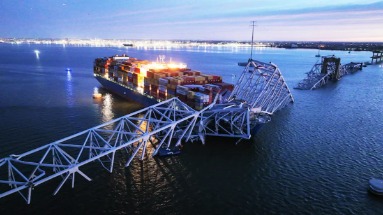
Advertisement
In the early hours of Tuesday morning, the collision between a colossal container ship, the Dali, and a support column of the Francis Scott Key Bridge in Baltimore sent shockwaves through the global supply chain and US coastal infrastructure. The impact crumpled the central span of the bridge into the frigid waters of the Patapsco River, severing the vital link between Baltimore’s port and the Atlantic Ocean. As rescue efforts unfolded, the grim reality of the disaster became apparent, with six missing individuals presumed dead after an exhaustive search spanning over 18 hours.
In the wake of the bridge collapse, the Port of Baltimore—a linchpin of the region’s shipping network—has ground to a halt, with all water traffic suspended indefinitely, as confirmed by the Maryland Port Administration. Despite this setback, trucks continue to ferry goods to and from the area, albeit facing logistical challenges. Baltimore ranks as the ninth busiest port in the United States for international trade, underscoring the far-reaching implications of the crash on regional, national, and global economies. The duration of the repair process for the 47-year-old bridge remains uncertain, leaving experts grappling with the potential economic ramifications.
The repercussions of the bridge collapse are particularly acute for industries reliant on Baltimore’s port facilities, including the automotive, agriculture, and construction sectors. Baltimore boasts the infrastructure and expertise necessary to handle “roll on, roll off” ships—vessels tailored for wheeled cargo—and serves as a crucial distribution hub for the densely populated Eastern Seaboard and Midwest regions. Last year alone, nearly 850,000 vehicles and over 1.3 million tons of farm and construction machinery passed through the port, highlighting its pivotal role in facilitating trade and commerce.
Despite the disruption, alternative routes exist for both incoming ships and overland transportation. The presence of tunnels traversing the Patapsco River offers a viable option for diverting traffic, while nearby ports such as Norfolk, Philadelphia, and Savannah can absorb some of the cargo typically handled by Baltimore. However, prolonged delays in resolving the crisis could exacerbate logistical challenges and lead to supply chain disruptions, potentially impacting prices across various industries.
The incident also underscores broader trends in the shipping industry, notably the proliferation of larger vessels driven by economic imperatives. The Dali, measuring nearly 1,000 feet in length, epitomizes the trend towards larger ships capable of carrying greater cargo volumes. However, this growth in vessel size has outpaced the evolution of infrastructure, leaving aging bridges ill-equipped to withstand such massive impacts. The Francis Scott Key Bridge, erected almost five decades ago, predates the era of mega-ships and lacks the robustness required to withstand collisions of this magnitude.
As recovery efforts unfold, authorities face the daunting task of addressing the structural vulnerabilities exposed by the bridge collapse. While advancements in engineering and technology offer potential solutions, the incident serves as a stark reminder of the imperative to modernize and fortify transportation infrastructure to meet the evolving demands of a dynamic global economy. Despite the challenges ahead, lessons learned from past disruptions, including the COVID-19 pandemic, may provide valuable insights into navigating the complexities of supply chain resilience and contingency planning in the aftermath of such tragedies.
